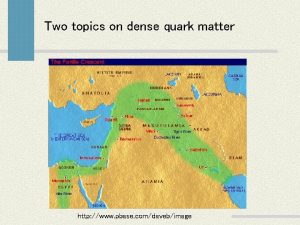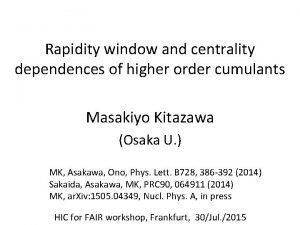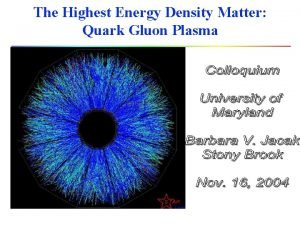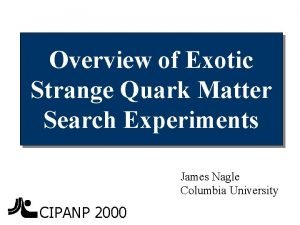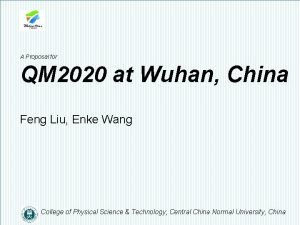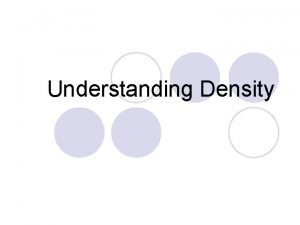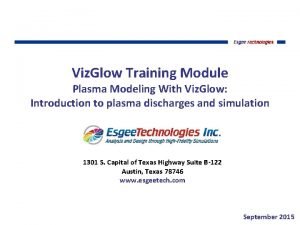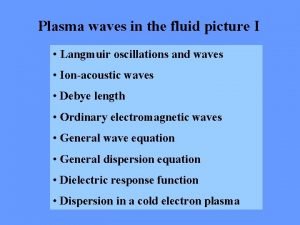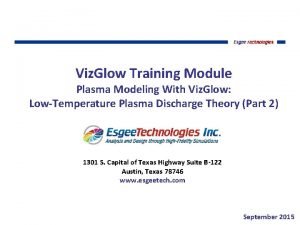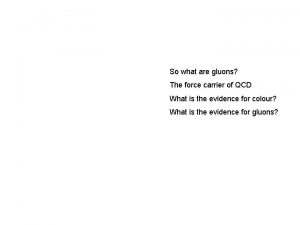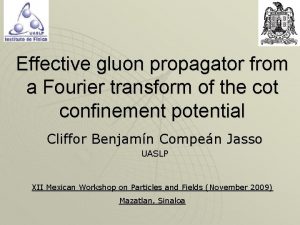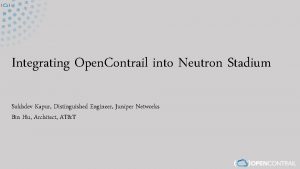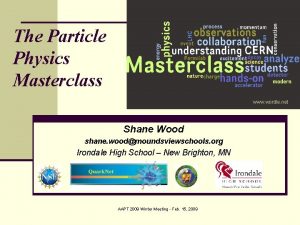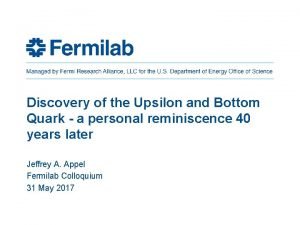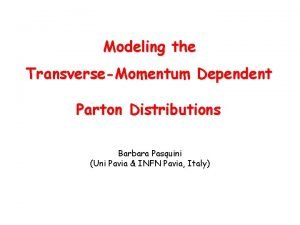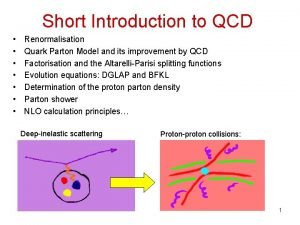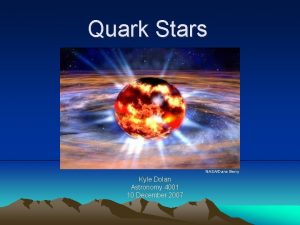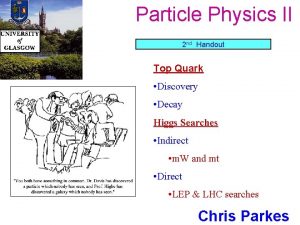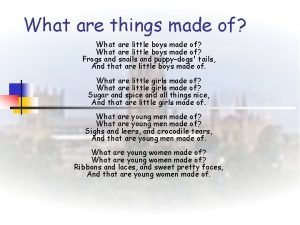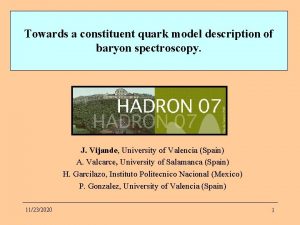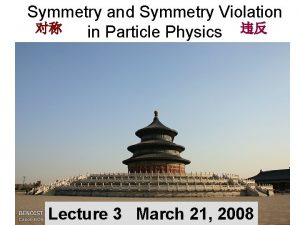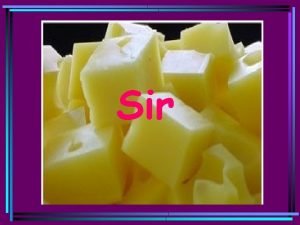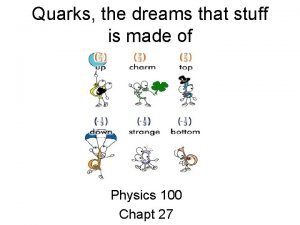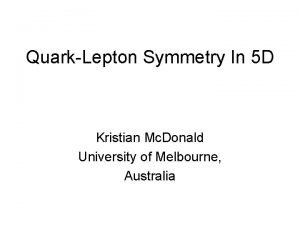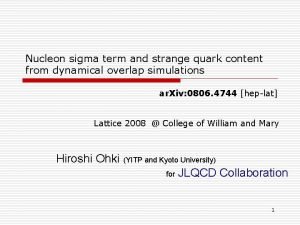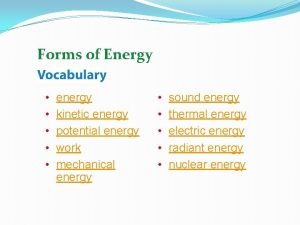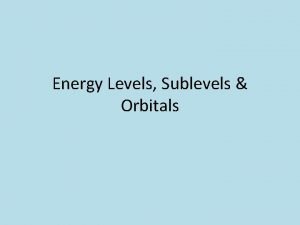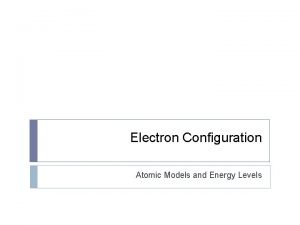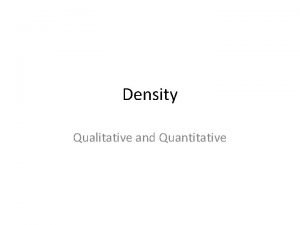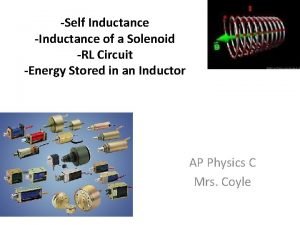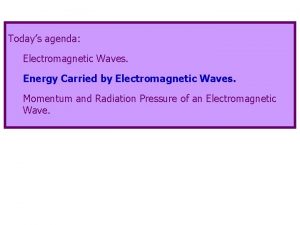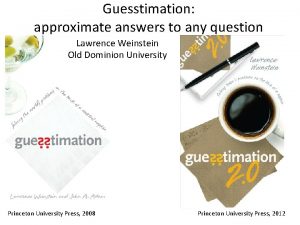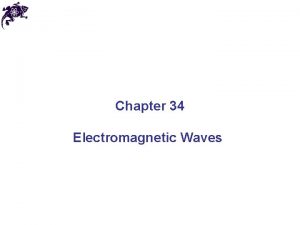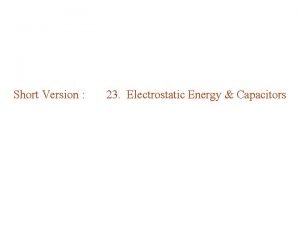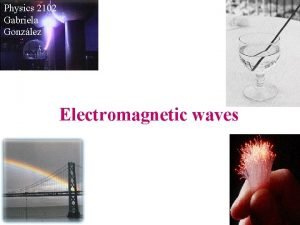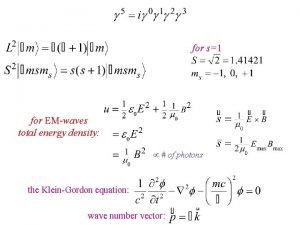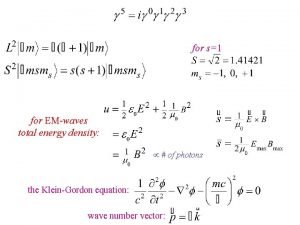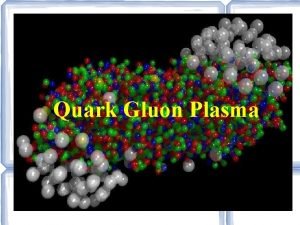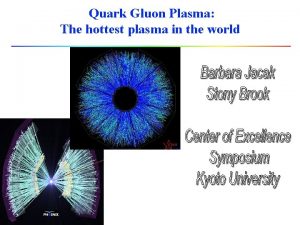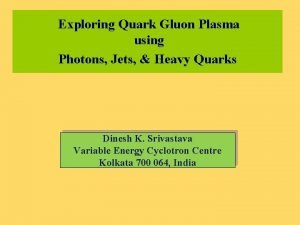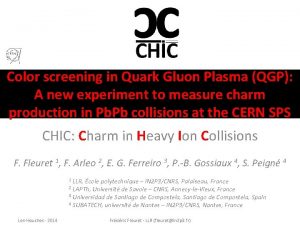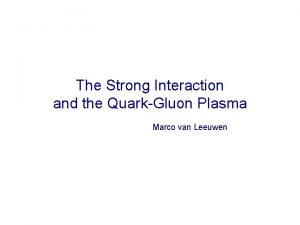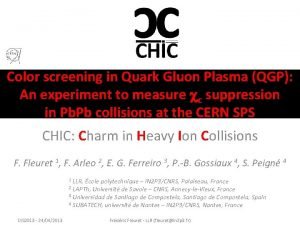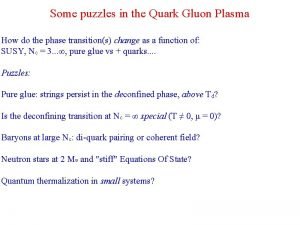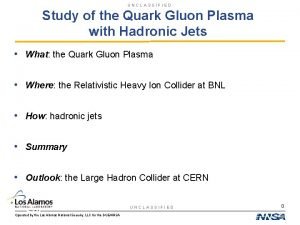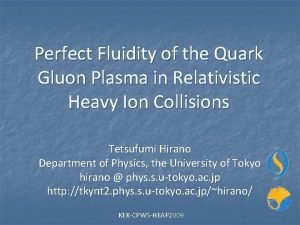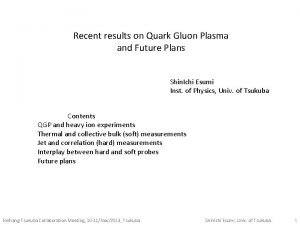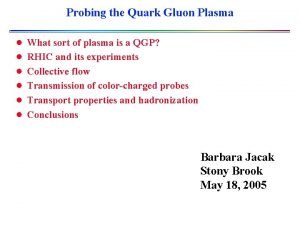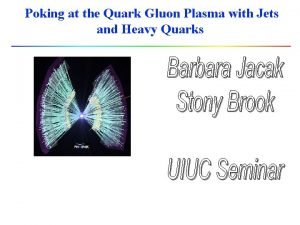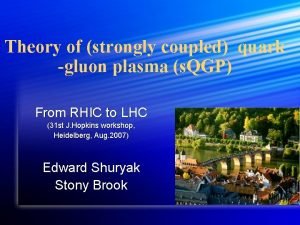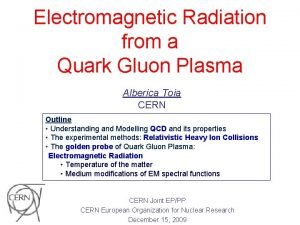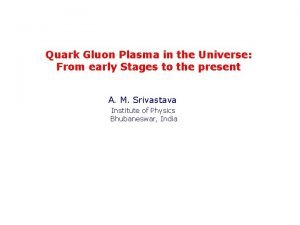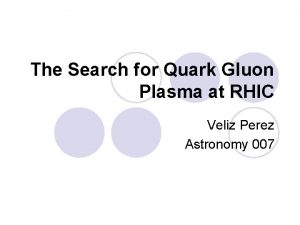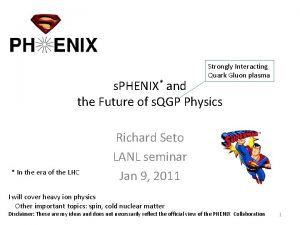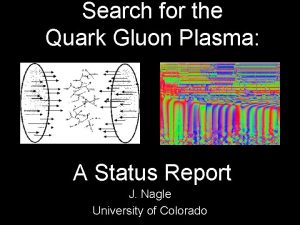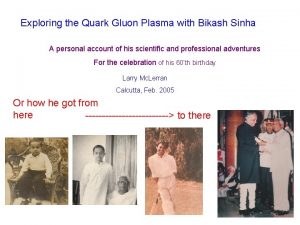The Highest Energy Density Matter Quark Gluon Plasma






























































- Slides: 62

The Highest Energy Density Matter: Quark Gluon Plasma

The physics of the quark gluon plasma l Energy densities characteristic of the early universe l l l Why expect a quark gluon plasma? Experimental study at RHIC Experiments and probes of the hot, dense matter What happens? Energy loss of fast quarks, gluons Collective motion: hydrodynamic flow First glimpse of the matter’s properties Underlying degrees of freedom & hadronization Conclusions & open questions

Locate on energy density map high energy density: e > 1011 J/m 3 P > 1 Mbar I > 3 X 1015 W/cm 2 Fields > 500 Tesla QGP energy density e > 1 Ge. V/fm 3 i. e. > 1030 J/cm 3

Quarks, gluons and hadrons l 6 quarks: 2 light (u, d), 1 sort of light (s), 2 heavy (c, b), 1 very heavy (t) Besides flavor, also have color quantum number l In normal life: quarks are bound into hadrons Baryons (e. g. n, p) have 3 Mesons (e. g. , K, f) have 2 (1 quark + 1 anti-quark) l Colored quarks interact by exchange of gluons (also have color) l Quantum Chromo Dynamics (QCD) Field theory of the strong interaction Parallels Quantum Electrodynamics (QED) but in EM interactions, exchanged photons electrically uncharged gluons carry color charge

QCD phase transition Color charge of gluons interact among themselves theory is non-abelian curious properties at large distance: confinement of quarks in hadrons + +… At high temperature and density: force is screened by produced color-charges expect transition to free gas of quarks and gluons

non-perturbative QCD – lattice gauge theory Karsch, Laermann, Peikert ‘ 99 e/T 4 ~15% from ideal gas of weakly interacting quarks & gluons T/Tc Tc ~ 170 ± 10 Me. V (1012 °K) e ~ 3 Ge. V/fm 3 required conditions to study quark gluon plasma

So, collide BIG ions at v ~ c l Reach T 170 Me. V; e > 3 Ge. V/fm 3 l Characterize the hot, dense medium Evidence for QCD phase transition to quark gluon plasma? does medium behave as a plasma? coupling weak or strong? What’s the density, temperature, radiation rate, collision frequency, conductivity, opacity, Debye screening length? l Probes passive (radiation) those created in the collision (“external”)

RHIC at Brookhaven National Laboratory Collide Au + Au ions for maximum volume s = 200 Ge. V/nucleon pair, p+p and d+A to compare

4 complementary experiments STAR

The Scope of the Tools (!) STAR specialty: large acceptance measurement of hadrons PHENIX specialty: rare probes, leptons, and photons

probing early stage of heavy ion collision e, pressure builds up Hard scattered q, g (short wavelength) probes of plasma formed , * e+e-, + Real and virtual photons emitted as thermal radiation. , K, p, n, f, L, D, X, W, d, Hadrons reflect (thermal) properties when inelastic collisions stop (chemical freeze-out). we focus on mid-rapidity (y=0), as it is the CM of colliding system 90° in the lab at collider

So what happens? l Lots of information collected over past 4 years l I’ll focus on a few important results l Start with the “external” probes Made in the first step in the collision Rate and spectrum calculable with (perturbative) QCD look for differences… Start by benchmarking the probe!

Start simple p+p collisions p-p PRL 91 (2003) 241803 0 Good agreement with NLO p. QCD p QCD works for high p transfer processes! Have a handle on initial NN interactions by scattering of q, g inside N We also need: Parton distribution functions Fragmentation functions

p. QCD in Au+Au? direct photons g+q +q TOT Au+Au 200 Ge. V/A: 10% most central collisions ( p. QCD x Ncoll) / background Vogelsang/CTEQ 6 Preliminary ( p. QCD x Ncoll) / ( background x Ncoll) [w/ the real suppression] [if there were no suppression] [ ]measured / [ ]background = p. T (Ge. V/c) measured/ background

Is the energy density high enough? PRL 87, 052301 (2001) Colliding system expands: R 2 2 ct 0 Energy to beam direction per unit velocity || to beam e 5. 5 Ge. V/fm 3 (200 Ge. V Au+Au) well above predicted transition! value is lower limit: longitudinal expansion rate, formation time overestimated

“external” probes of the medium Hard scattering of q, g early. Observe fast leading particles, back-back correlations Before creating hadron jets, scattered quarks induced to radiate energy (~ Ge. V/fm) by the colored medium -> jet quenching schematic view of jet production hadrons leading particle q q hadrons leading particle AA AA <Nbinary>/sinelp+p nucleon-nucleon cross section AA

Au-Au s = 200 Ge. V: high p. T suppressed! PRL 91, 072301(2003)

look for the jet on the other side Peripheral Au + Au STAR PRL 90, 082302 (2003) near side Central Au + Au away side peripheral Medium is opaque! central

Suppression: a final state effect? Hot, dense medium causes Such a medium is absent in d+Au collisions! But Au provides all initial state effects of q, g wavefunction inside a Au nucleus d+Au is the “control” experiment

Experiments show NO suppression in d+Au! PHENIX Preliminary 0 STAR Preliminary PHOBOS Preliminary

Centrality Dependence Au + Au Experiment d + Au Control PHENIX preliminary l Dramatically different and opposite centrality evolution of Au. Au experiment from d. Au control. l Jet Suppression is clearly a final state effect.

Are back-to-back jets there in d+Au? Yes! Pedestal&flow subtracted leading particle suppressed hadrons So this is the right picture for Au+Au q q ?

Collective motion? Pressure: a barometer called “elliptic flow” Origin: spatial anisotropy of the system when created, followed by multiple scattering of particles in the evolving system spatial anisotropy momentum anisotropy v 2: 2 nd harmonic Fourier coefficient in azimuthal distribution of particles with respect to the reaction plane Almond shape overlap region in coordinate space

v 2 measured by the experiments 200 Ge. V: 0. 2< pt < 2. 0 130 Ge. V: 0. 075< pt < 2. 0 200 Ge. V: 0. 150< pt < 2. 0 4 -part cumulants STAR v 2=0. 05 STAR Preliminary 200 Ge. V: Preliminary

v 2 reproduced by hydrodynamics Hydro. Calculations Huovinen, P. Kolb, U. Heinz STAR PRL 86 (2001) 402 • see large pressure buildup • anisotropy happens fast • early equilibration ! central Hydrodynamics assumes early equilibration Initial energy density is input Equation of state from lattice QCD Solve equations of motion

Collective effect probes early phase Kolb, et al Hydrodynamics can reproduce magnitude of elliptic flow for , p. BUT correct mass dependence requires softer than hadronic EOS!! NB: these calculations have viscosity = 0 medium behaves as an ideal liquid

So, what do E loss & collectivity tell us? l Medium is “sticky” or opaque to colored probes l Thermalization must be very fast (< 1 fm/c) l Constrain hydrodynamic, energy loss models with data: Energy loss <d. E/dz> (Ge. V/fm) 7 -10 0. 5 in cold matter Energy density (Ge. V/fm 3) 14 -20 >5. 5 from ET data d. N(gluon)/dy ~1000 200 -300 at SPS T (Me. V) 380 -400 Experimentally unknown as yet Equilibration time t 0 (fm/c) 0. 6 Parton cascade agrees Opacity (L/mean free path) 3. 5

Is s enough for fast equilibration & large v 2 ? Parton cascade using free q, g scattering cross sections underpredicts pressure must increase x 50 Lattice QCD shows qq resonant states at T > Tc, also implying high interaction cross sections

Plasma coupling parameter? l Very high gluon density estimate G = <PE>/<KE> using QCD coupling strength <PE>=g 2/d d ~1/(41/3 T) <KE> ~ 3 T g 2 ~ 4 -6 (value runs with T) G ~ g 2 (41/3 T) / 3 T so plasma parameter G ~ 3 NB: such plasmas known to behave as a liquid! l May have bound q, g states, but not color neutral l So the quark gluon plasma is a strongly coupled plasma As in warm, dense plasma at lower (but still high) T But strong interaction rather than electromagnetic

Underlying degrees of freedom? l Should be quarks and gluons in the early (QGP) stage l Experimental evidence for this? Look at production of final state particles with different number of quarks Baryons have 3, mesons have 2 l Recall comparison of proton and pion collective flow constrained equation of state

More energetic baryons in Au+Au PRL 91 (2003) 172301 p/ ~1 at high p. T in central collisions > p+p, d+Au > peripheral Au+Au >jets in e+ecollisions

Are extras from thermal medium? Hydrodynamic expansion common velocity boost R. Fries, et al heavier particles boosted to higher p. T enhances mid p. T hadrons baryons especially Do the hadrons get boosted? or Coalescence of boosted quarks into hadrons? p. QCD spectrum shifted by 2. 2 Ge. V Teff = 350 Me. V

~RAA But baryons show jet-like properties too… Baryons scale Ncoll ! f follows the mesons Kinematics determined by quark content

Elliptic flow scales as number of quarks v 2 scales ~ with # of quarks! evidence for quarks as relevant d. o. f. when pressure built up

equilibrated final state, including s quarks Hadron yields in agreement with Grand Canonical ensemble T(chemical freeze-out) ~ 175 Me. V (multi)strange hadrons enhanced over p+p, but QGP hypothesis not unique explanation

How about J/Y suppression? l J/Y Test confinement: do bound c + c survive? or does QGP screening kill them? Need (a lot) more statistics (currently being analyzed) But can take a first look…

Color screening? 40 -90% 20 -40% most central Ncoll=45 Ncoll=296 This data inconclusive 0 -20% most central Ncoll=779 Lattice predictions for heavy quarks

conclusions Evidence is mounting that RHIC creates a strongly coupled, opaque plasma still is debate in community about standard of proof l With aid of hydrodynamic, l-QCD and p-QCD models: e ~ 15 Ge. V/fm 3 d. Ngluon/dy ~ 1000 sint large for T < 2 -3 Tc l Equation of state not hadronic! l Have evidence that thermalized q, g produce the particles observed in the final state l Will learn screening properties via cc bound states l Are poised to characterize this new kind of plasma T, radiation rate, conductivity, collision frequency

Saturation of gluons in initial state (colored glass condensate) Mueller, Mc. Lerran, Kharzeev, … Wavefunction of low x (very soft) gluons overlap and the self-coupling gluons fuse. gg g r/ Saturation at higher x at RHIC vs. HERA due to nuclear size suppressed jet cross section; no back-back pairs d + Au collisions cent/periph. (~RAA)

Open charm: baseline is p+p collisions PHENIX PRELIMINARY Measure charm s via semi-leptonic decay to e+ & e 0, h, photon conversions are measured and subtracted fit p+p data to get the baseline for d+Au and Au+Au.

Charm production s scales as Ncoll! The yellow band represents the set of alpha values consistent with the data at the 90% Confidence Level.

No large suppression as for light quarks! PHENIX PRELIMINARY Curves are the p+p fit, scaled by the number of binary collisions

Evidence for equilibrated final hadronic state BRAHMS l Simple quark counting: From y=0 to 3 K-/K+ = exp(2 ms/T)exp(-2 mq/T) = exp(2 ms/T)(pbar/p)1/3 = (pbar/p)1/3 l local strangeness At y=0 conservation K-/K+=(pbar/p)a a = 0. 24± 0. 02 BRAHMS a = 0. 20± 0. 01 for SPS l Good agreement with PRL 90 102301 Mar. 2003 statistical-thermal model of Beccatini et al. (PRC 64 2001) w/T=170 Me. V

Implications of the results for QGP l Ample evidence for equilibration l initial d. N(gluon)/dy ~ 1000, energy density ~ 15 Ge. V/fm 3, energy loss ~ 7 -10 Ge. V/fm l Very rapid, large pressure build up requires parton interaction cross sections 50 x perturbative s

How to get 50 times p. QCD s? spectral function • Lattice indicates that hadrons don’t all melt at Tc! hc bound at 1. 5 Tc Asakawa & Hatsuda, PRL 92, 012001 (2004) charmonium bound states up to ~ 1. 7 Tc Karsch; Asakawa&Hatsuda , s survive as resonances Schaefer & Shuryak, PLB 356 , 147(1995) l q, g have thermal masses at high T. as runs up at T>Tc? (Shuryak and Zahed) would cause strong rescattering qq meson

E. Shuryak

Implications of the results for QGP l Ample evidence for equilibration l v 2 & jet quenching measurements constrain initial gluon density, energy density, and energy loss l parton interaction cross sections 50 x perturbative s parton correlations at T>Tc complicates cc bound states as deconfinement probes! l Hadronization by coalescence of thermal, flowing quarks v 2 & baryon abundances point to quark recombination as hadronization mechanism Jet data imply must also include recombination between quarks from jets and thermalized medium modifies jet fragmentation!

Locate RHIC on phase diagram early universe From fit of yields vs. mass (grand canonical ensemble): 250 RHIC 200 quark-gluon plasma T 150 Lattice QCD SPS AGS deconfinement chiral restauration thermal freeze-out 100 SIS hadron gas 50 neutron stars atomic nuclei 0 0 200 400 600 800 1000 1200 Baryonic Potential B [Me. V] Tch = 176 Me. V m. B = 41 Me. V These are the conditions when hadrons stop interacting Observed particles “freeze out” at/near the deconfinement boundary!

Do see Cronin effect! (h++h-)/2 “Cronin” enhancement more pronounced in the charged hadron measurement Possibly larger effect in protons at mid p. T Implication of Rd. Au? RHIC at too high x for gluon saturation… 0

How about Color Glass Condensate? Central: Enhanced not suppressed PHENIX preliminary y=0 Rda No CGC signal at mid-rapidity So, perhaps G-sat. >2 Xc(A) Rda p. QCD BFKL, DGLAP RHIC Log Q 2 Pt (Ge. V/c) Peripheral d+Au (like p+p)

But at forward rapidity reach smaller x y = 3. 2 in deuteron direction x 10 -3 in Au nucleus Strong shadowing, maybe even saturation? d Au Phenix Preliminary

Why no energy loss for charm quarks? l “dead cone” predicted by Kharzeev and Dokshitzer, Phys. Lett. B 519, 199 (1991) l Gluon bremsstrahlung: k. T 2 = m 2 tform/l transverse momentum of radiated gluon m =p. T in single scatt. l =mean free path q ~ k. T / w w = gluon energy l But radiation is suppressed below angles q 0= Mq/Eq soft gluon distribution is d. P = as. CF/ dw/w k. T 2 dk. T 2/(k. T 2+ w 2 q 02) 2 not small for heavy quarks! causes a dead cone

, K, p, pbar spectra indicate pressure Look at “transverse mass” m. T 2 = p. T 2 + m 02 — is distribution e-E/T? i. e. Boltzmann distribution from thermalized gas? yes ! Protons are flatter velocity boost to beam Result of pressure built up

QCD Phase Transition l Basic (i. e. hard) questions how does process of quark confinement work? how nature breaks symmetries massive particles from ~ massless quarks l transition affects evolution of early universe latent heat & surface tension matter inhomogeneity in evolving universe equation of state compression in stellar explosions l Study simple complex systems: p+p, “p”+A, A+A collisions

did something new happen at RHIC? we look for physics beyond simple superposition of NN at low momentum/large distance scales: l Study collision dynamics (via final state) Equilibrium? hadron spectra, yields Collective behavior? i. e. pressure and expansion elliptic, radial flow l Probe the early (hot) phase Must create probes in the collision itself: predictable quantity, interact differently in QGP vs. hadron matter vacuum QGP fast quarks/gluons, J/Y, D mesons thermal radiation

J/Y suppression was observed at CERN at s=18 Ge. V/A NA 50 collaboration J/Y yield Fewer J/Y in Pb+Pb than expected! Interpret as color screening of c-cbar by the medium Initial state processes affect J/Y too so interpretation heavily debated. . .

The Physics of Heavy Ion Collisions l Create very high temperature and density matter similar to that existing ~1 msec after the Big Bang distance between hadrons comparable to that in neutron stars study only in the lab – relics from Big Bang inaccessible l Goal is to characterize the hot, dense medium expect QCD phase transition to quark gluon plasma does medium behave as a plasma? find density, temperature, radiation rate, collision frequency, conductivity, opacity, Debye screening length? probes: passive (radiation) and those created in the collision l Collide Au + Au ions for maximum volume s = 200 Ge. V/nucleon pair, p+p and d+A to compare

Predicted signatures of QGP l Debye screening of color charges (Matsui & Satz) Suppresses rate of c-c bound state (J/Y) l Strangeness enhancement (Rafelski & Mueller) Tplasma ~ masss-quark Enhances strange hadron yields (e. g. K/ increased) l Jet quenching (Gyulassy & Wang) Dense medium induces coherent gluon radiation Decreased yield of jets of hadrons from hard scattered quarks or gluons

Where does the lost energy go? preliminary Away side jet is significantly broadened Au+Au 0 -5% • recover the energy in hadrons ~ 500 Me. V • comparable to <p. T> of the bulk medium • lost energy is thermalized STAR Preliminary p. T > 200 Me. V Df

Suppression: an initial state effect? l Gluon Saturation probe rest frame (color glass condensate) Wavefunction of low x gluons overlap; the selfcoupling gluons fuse, saturating the density of gluons in the initial state. (gets Nch right!) Levin, Ryshkin, Mueller, Qiu, Kharzeev, Mc. Lerran, Venugopalan, Balitsky, Kovchegov, Kovner, Iancu … • Multiple elastic scatterings (Cronin effect) Wang, Kopeliovich, Levai, Accardi gg g r/ Rd. Au~ 0. 5 D. Kharzeev et al. , hep-ph/0210033 Broaden p. T :

Property probed: density Induced gluon brehmsstrahlung p. QCD calculation depends on number of scatterings Agreement with data: initial gluon density d. Ng/dy ~ 1100 e ~ 15 Ge. V/fm 3 d. Au hydro initial state same Lowest energy radiation sensitive to infrared cutoff. Au-Au d-Au

Evolution of the Universe Too hot for quarks to bind!!! Standard Model (N/P) Physics Quark. Gluon Plasma? ? Too hot for nuclei to bind Nuclear/Particle (N/P) Physics Hadron Gas Nucleosynthesis builds nuclei up to He Nuclear Force…Nuclear Physics Universe too hot for electrons to bind E/M Plasma E-M…Atomic (Plasma) Physics Solid Liquid Gravity…Newtonian/General Relativity Gas Today’s Cold Universe
 Quark gluon plasma
Quark gluon plasma Quark gluon
Quark gluon Quark gluon plasma
Quark gluon plasma Quark gluon
Quark gluon Color quarks
Color quarks Quark matter 2022
Quark matter 2022 Flow energy review
Flow energy review What stands for
What stands for Debye length
Debye length Plasma density formula
Plasma density formula Sheath plasma
Sheath plasma What are gluons
What are gluons Gluon propagator
Gluon propagator Gluon plugin
Gluon plugin Example of plasma state of matter
Example of plasma state of matter Quark physics wordle
Quark physics wordle Quark names
Quark names Quark model
Quark model Quark parton model
Quark parton model Quark astronomy
Quark astronomy Top quark decay
Top quark decay Quark names
Quark names Constituent quark model
Constituent quark model A charm quark has a charge of approximately
A charm quark has a charge of approximately Caprodur sir
Caprodur sir 6 types of quarks
6 types of quarks Quark lepton symmetry
Quark lepton symmetry Sigma quark composition
Sigma quark composition Sg formula
Sg formula Planer density
Planer density Crude population density vs physiological density
Crude population density vs physiological density Linear density of atoms
Linear density of atoms High density low density
High density low density Physiological density egypt
Physiological density egypt Kinetic energy example
Kinetic energy example Forms of energy
Forms of energy Energy levels and orbitals
Energy levels and orbitals Energy levels periodic table
Energy levels periodic table What is the highest occupied energy level?
What is the highest occupied energy level? Is density qualitative or quantitative
Is density qualitative or quantitative Classification of matter section 1 composition of matter
Classification of matter section 1 composition of matter Grey matter nervous system
Grey matter nervous system Composition of matter section 1
Composition of matter section 1 Chapter 2 section 1 classifying matter answers
Chapter 2 section 1 classifying matter answers Arbor vitae
Arbor vitae Classification of matter section 1 composition of matter
Classification of matter section 1 composition of matter Gray matter and white matter
Gray matter and white matter Gray matter
Gray matter Energy energy transfer and general energy analysis
Energy energy transfer and general energy analysis Energy energy transfer and general energy analysis
Energy energy transfer and general energy analysis Volume of solenoid formula
Volume of solenoid formula Do electromagnetic waves carry energy
Do electromagnetic waves carry energy Xkcd uranium energy density
Xkcd uranium energy density Energy density of electromagnetic waves
Energy density of electromagnetic waves Electrostatic energy
Electrostatic energy Conductor
Conductor Intensity of electromagnetic wave
Intensity of electromagnetic wave Energy density formula
Energy density formula Formula of energy density
Formula of energy density Hát kết hợp bộ gõ cơ thể
Hát kết hợp bộ gõ cơ thể Ng-html
Ng-html Bổ thể
Bổ thể Tỉ lệ cơ thể trẻ em
Tỉ lệ cơ thể trẻ em
